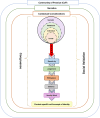A systematic scoping review of mentoring support on professional identity formation
- PMID: 39605048
- PMCID: PMC11600620
- DOI: 10.1186/s12909-024-06357-3
A systematic scoping review of mentoring support on professional identity formation
Abstract
Background: Mentoring's success in nurturing professional identity formation (PIF) has been attributed to its ability to build personalised and enduring mentoring relationships. However, beyond functioning as communities of practice (CoPs) supporting socialisation processes, how mentoring integrates programme values and instils a shared identity amongst mentees remains unclear. The need for personalised guidance and timely attention to a mentee's unique needs in evolving mentoring relationships point to the critical role of support mechanisms ('mentoring support'). We conducted a systematic scoping review (SSR) studying "What is known about mentoring support's role in nurturing PIF?".
Methods: Adopting PRISMA-ScR guidelines, this SSR was guided by the Systematic Evidence-Based Approach (SEBA). Independent searches were carried out on publications featured between 1st January 2000 and 30th June 2023 in PubMed, Embase, ERIC and Scopus databases. The Split Approach saw concurrent, independent thematic and content analyses of the included articles. The Jigsaw Perspective combined complementary themes and categories, creating broader themes/categories. The subsequent Funnelling Process formed key domains that platformed the synthesis of the discussion.
Results: Two thousand three hundred forty-one abstracts were reviewed, 323 full-text articles were appraised and 151 articles were included and analysed. The key domains identified were (1) definitions and roles; (2) personalisation; (3) shepherding; and (4) PIF.
Conclusion: The success of mentoring in PIF lies in its ability to blend role modelling, supervision, mentoring, coaching and teaching, with self-care, guided reflection, apprenticeship and assessment to meet the individual needs of the mentee and their changing circumstances. Blending the contents of the mentoring umbrella emphasises the critical role of the mentor and host organisation in supporting mentor training, communications, support and assessment mechanisms. Mentee engagement and its active role in support measures complement the CoP-like mentoring programme's use of blending mentoring support to advance the socialisation process. These insights reflect a complex interactive process scaffolding the development of mentoring relationships and PIF. The effect of the mentoring umbrella on clinical practice requires further study.
Keywords: Apprenticeship; Coaching; Medical schools; Medicine; Mentor; Mentoring; Mentoring relationships; Mentoring support; Professional identity formation; Role modelling; Supervision.
© 2024. The Author(s).
Conflict of interest statement
Declarations. Ethics approval and consent to participate: Not applicable. Consent for publication: Not applicable. Competing interests: The authors declare no competing interests.
Figures







References
-
- Lin J, Chew YR, Toh YP, Krishna LKR. Mentoring in nursing: an integrative review of commentaries, editorials, and perspectives papers. Nurse Educ. 2018;43(1):E1–5. - PubMed
-
- Toh YP, Karthik R, Teo CC, Suppiah S, Cheung SL, Krishna LKR. Toward mentoring in palliative social work: a narrative review of mentoring programs in social work. Am J Hosp Palliat Care. 2018;35(3):523–31. - PubMed
Publication types
MeSH terms
LinkOut - more resources
Full Text Sources

